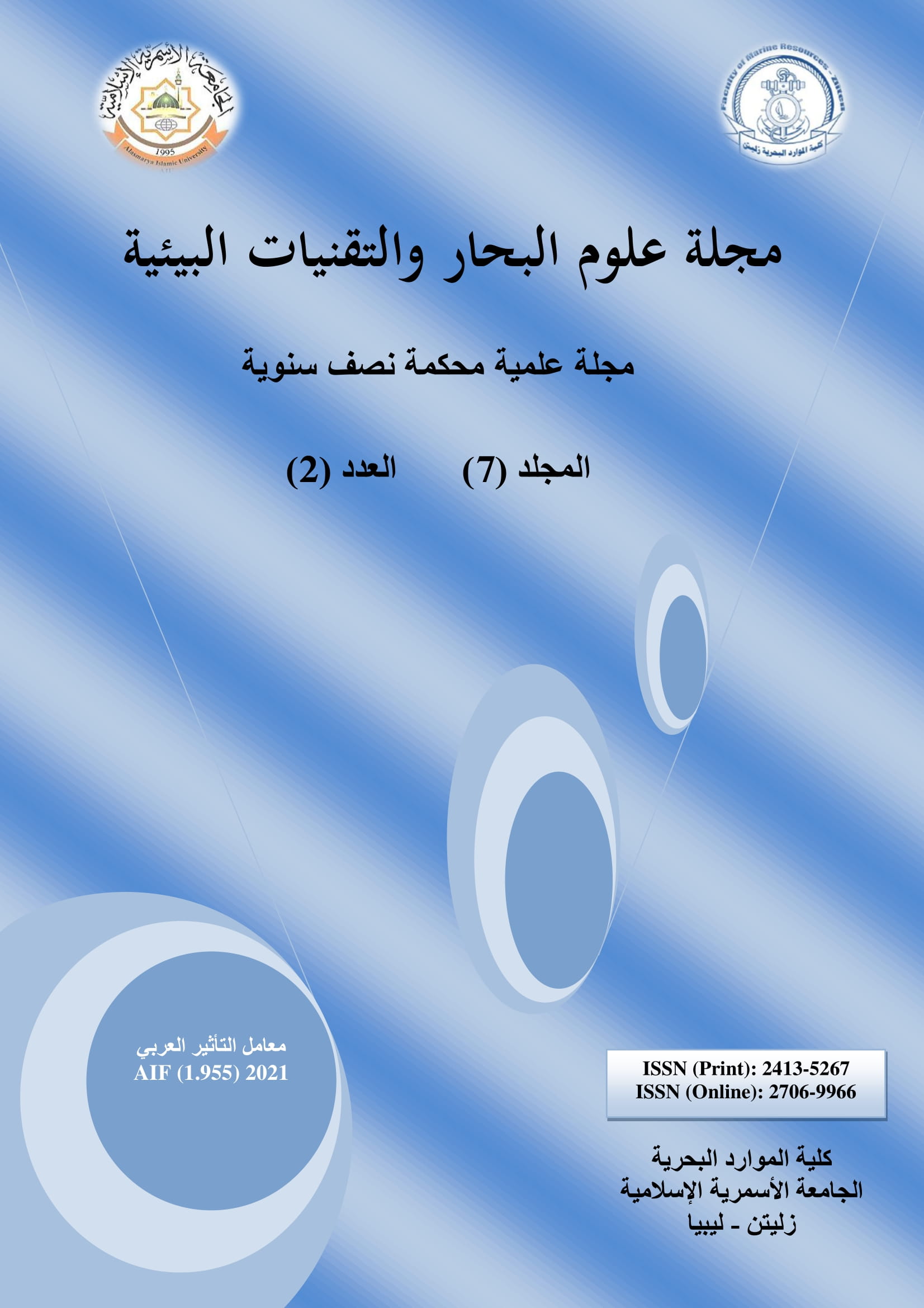تحسين خاصية الحماية من التآكل للصلب المنخفض الكروم في البيئات الرطبة
DOI:
https://doi.org/10.59743/jmset.v7i2.25الكلمات المفتاحية:
الصلب المنخفض الكروم، مقاومة الأكسدة،، التآكل، بخار الماء، الأكسجين الحرالملخص
يستخدم الصلب منخفض الكروم فى الصناعات النفطية والبتروكيميائية على نطاق واسع لقدرته على التخميل وحماية نفسه من التآكل، ولكن عند وجود الكروم بكمية منخفضة تم تسجيل معدلات تآكل أعلى لهذا الصلب في الأجواء الرطبة. أجريت اختبارات الأكسدة للصلب P-5(5%Cr) و(9%Cr)P-91 في خليط من الغازات ممثل بالصيغة 21% نيتروجين و 79% بخار ماء عند درجة حرارة 500oم باستخدام تقنية التحليل الحراري الوزني(TGA). أظهرت نتائج الاختبارات أن الصلب P-91 يحتفظ بمقاومة أكسدة أفضل من الصلب P-5 في بيئة (H2O+N2)، كما أدى إضافة الأكسجين الحر إلى تقليل معدل تآكل الصلب P-5 بمعدل يصل إلى 42%، إضافة إلى ذلك يمكن تحسين مقاومة التآكل للصلب P-5 إما عن طريق زيادة محتوى الكروم من 5 إلى 9% أو إضافة الأكسجين الحر 4 أضعاف كمية الماء الموجودة في البيئة الرطبة المدروسة.
التنزيلات
المراجع
Asteman H., Svensson J.E., Johansson L.G., and Norell M. (1999). Indication of chromium oxide hydroxide evaporation during oxidation of 304L at 873 K in the presence of 10% water vapor. Oxidation of Metals, 52(1): 95-111.
Asteman H., Svensson J.E., Norell M., and Johansson L.G. (2000). Influence of water vapor and flow rate on the high-temperature oxidation of 304L; effect of chromium oxide hydroxide evaporation. Oxidation of metals, 54(1): 11-26.
Bamba G., Wouters Y., Galerie A., Borchardt G., Shimada S., Heintz O., and Chevalier S. (2007). Inverse growth transport in thermal chromia scales on Fe–15Cr steels in oxygen and in water vapour and its effect on scale adhesion. Scripta Materialia, 57(8): 671-674.
Cheng S.Y., Kuan S.L., and Tsai W.T. (2006). Effect of water vapor on annealing scale formation on 316 SS. Corrosion Science, 48(3): 634-649.
Cheng X., Jiang Z., Monaghan B.J., Wei D., Longbottom R.J., Zhao J., and Jiang L. (2016). Breakaway oxidation behaviour of ferritic stainless steels at 1150 C in humid air. Corrosion Science, 108: 11-22.
Ehlers J., Young D.J., Smaardijk E.J., Tyagi A.K., Penkalla H.J., Singheiser L., and Quadakkers W.J. (2006). Enhanced oxidation of the 9% Cr steel P91 in water vapour containing environments. Corrosion science, 48(11): 3428-3454.
Erdoğan M., Sultan A., and Karakaya İ. (2017). Oxidation of Low Chromium Steels in Dry and Moist Atmospheres.Oxidation Communications, 40 (1-I): 51-60.
Essuman E., Meier G.H., Żurek J., Hänsel M., and Quadakkers W.J. (2008). The effect of water vapor on selective oxidation of Fe–Cr alloys. Oxidation of metals, 69(3): 143-162.
Essuman E., Meier G.H., Żurek J., Hänsel M., Singheiser L., and Quadakkers W.J. (2007). Enhanced internal oxidation as trigger for breakaway oxidation of Fe–Cr alloys in gases containing water vapor. Scripta Materialia, 57(9): 845-848.
Fujii C.T.and Meussner R.A. (1964). The Mechanism of the High‐Temperature Oxidation of Iron‐Chromium Alloys in Water Vapor. Journal of the Electrochemical Society, 111(11): 1215.-1221.
Henry S., Mougin J., Wouters Y., Petit J.P., and Galerie A. (2000). Characterization of chromia scales grown on pure chromium in different oxidizing atmospheres. Materials at High Temperatures, 17(2): 231-234.
Mathiazhagan P. and Khanna A.S. (2011). High Temperature Oxidation Behavior of P91, P92 and E911 Alloy Steels in Dry andWet Atmospheres. High Temp. Mater. Proc., 30: 43–50.
Mikkelsen L. and Linderoth S. (2003). High temperature oxidation of Fe–Cr alloy in O2–H2–H2O atmospheres; microstructure and kinetics. Materials Science and Engineering: A, 361(1-2): 198-212.
Nakai M., Nagai K., Murata Y., Morinaga M., Matsuda S., and Kanno M. (2005). Correlation of high-temperature steam oxidation with hydrogen dissolution in pure iron and ternary high-chromium ferritic steel. ISIJ international, 45(7): 1066-1072.
Pieraggi B., Rolland C., and Bruckel P. (2005). Morphological characteristics of oxide scales grown on H11 steel oxidised in dry or wet air. Materials at High Temperatures, 22(1-2): 61-68.
Stott F.H., Wood G.C., Whittle D.P., Bastow B.D., Shida Y., and Martinez-Villafane A. (1984). The transport of oxygen to the advancing internal oxide front during internal oxidation of nickel-base alloys at high temperature. Solid State Ionics, 12: 365-374.
Sultan A., Karakaya İ., and Erdoğan M. (2012). Influence of water vapour on high temperature oxidation of steels used in petroleum refinery heaters. Materials and Corrosion, 63(2): 119-126.
Tveten B., Hultquist G., and Norby T. (1999). Hydrogen in chromium: influence on the high-temperature oxidation kinetics in O2, oxide-growth mechanisms, and scale adherence. Oxidation of Metals, 51(3): 221-233.
Żurek J., Michalik M., Schmitz F., Kern T.U., Singheiser L., and Quadakkers W.J. (2005). The effect of water-vapor content and gas flow rate on the oxidation mechanism of a 10% Cr-ferritic steel in Ar-H 2 O mixtures. Oxidation of metals, 63(5): 401-422.
التنزيلات
منشور
إصدار
القسم
الرخصة
الحقوق الفكرية (c) 2021 مجلة علوم البحار والتقنيات البيئية

هذا العمل مرخص بموجب Creative Commons Attribution 4.0 International License.












